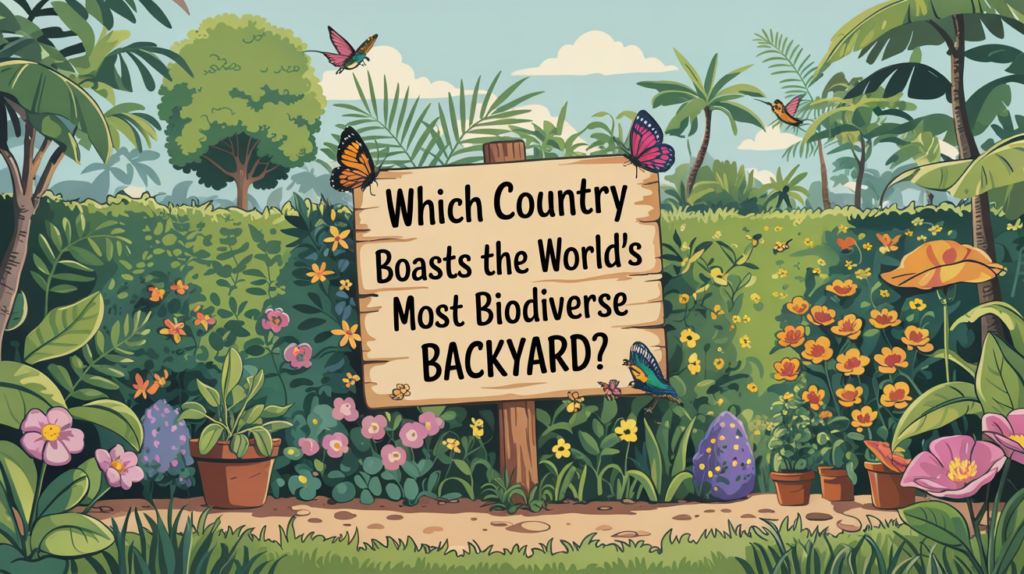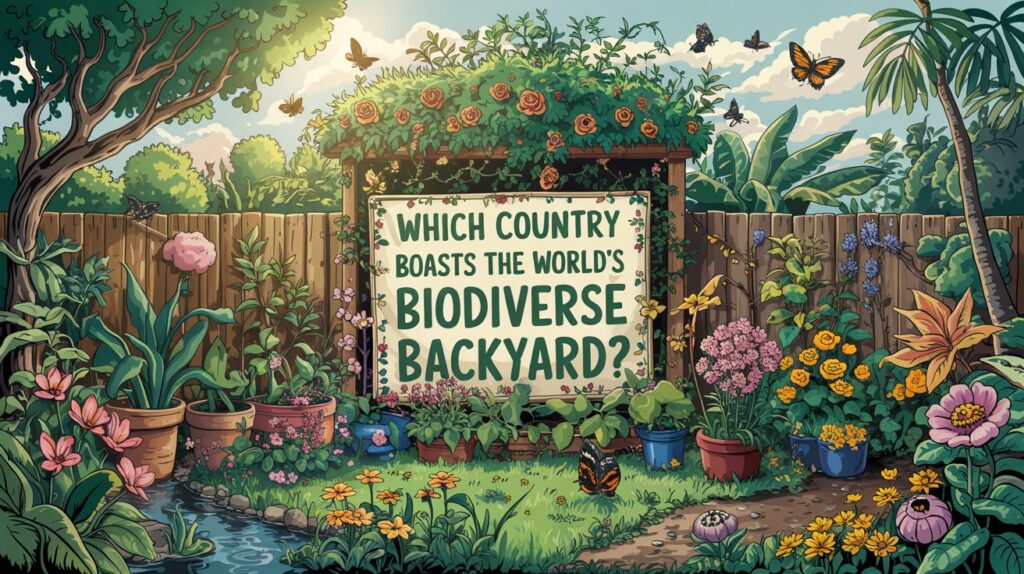Imagine a place where every step reveals a new creature, every glance uncovers a vibrant plant, and every breath fills you with the hum of life. Biodiversity isn’t just a buzzword—it’s the heartbeat of our planet. But which country is considered to have the highest density of biodiversity in the world? Let’s dive into this wild, wondrous question and explore the contenders, the science, and the jaw-dropping ecosystems that make certain corners of Earth explode with life. Buckle up—this journey takes us deep into jungles, up mountains, and across oceans!
What Makes Biodiversity Tick?
Biodiversity isn’t just about counting species. It’s about the variety of life—plants, animals, fungi, and even microbes—thriving in harmony. Several factors crank up the biodiversity dial. Geographic location plays a starring role. Countries straddling the equator soak up tropical vibes, fostering lush habitats. Climate joins the party, too. Warm, wet conditions turbocharge growth, while icy poles slow things down. Topography seals the deal. Mix rugged mountains with sprawling forests and coastlines, and you’ve got a recipe for a species-packed paradise.
So, which country is considered to have the highest density of biodiversity in the world? Density means species per square kilometer, not just total numbers. Big countries might hoard more species overall, but smaller ones can pack a denser punch. Let’s meet the heavyweights vying for the crown.
Brazil: The Amazonian Giant
Picture this: a forest so vast it swallows horizons, teeming with jaguars, piranhas, and trees older than history. Brazil dominates biodiversity talks for a reason. The Amazon rainforest sprawls across its heart, hosting millions of species. Scientists estimate 400 billion individual trees from 16,000 species tower here. Monkeys howl, toucans flaunt rainbow beaks, and river dolphins glide through murky waters. Brazil’s size—8.5 million square kilometers—gives it room to flex.
But density? That’s trickier. Brazil’s massive land dilutes its species-per-kilometer stats. Still, the sheer volume of life dazzles. Frogs glow with poison, butterflies dance in clouds, and orchids bloom in secret nooks. No wonder experts often crown it the biodiversity king—though not always for density.
Colombia: The Ecosystem Extravaganza
Now, shrink the canvas but crank up the variety. Colombia struts onto the stage with swagger. Rainforests hug the Amazon’s edge, while the Andes Mountains slice through, creating sky-high habitats. Coastal mangroves and Caribbean reefs add flair. Birds steal the show—over 1,900 species flutter here, more than anywhere else. Think iridescent hummingbirds and majestic Andean condors.
Colombia squeezes this into 1.1 million square kilometers. That’s a fraction of Brazil’s sprawl, yet it rivals its neighbor in species count. Amphibians croak in misty valleys, orchids paint the slopes, and jaguars prowl. Experts whisper that Colombia’s biodiversity density might edge out Brazil’s. Which country is considered to have the highest density of biodiversity in the world? Colombia’s compact chaos makes a strong case.

Ecuador: Small but Mighty
Size doesn’t always matter—just ask Ecuador. This pint-sized marvel, clocking in at 283,561 square kilometers, punches way above its weight. The Amazon blankets its east, the Andes pierce its spine, and the Pacific kisses its shores. Then there’s the Galapagos Islands—a living lab of evolution. Giant tortoises lumber, blue-footed boobies dance, and marine iguanas bask on volcanic rocks.
Ecuador’s secret? Diversity in tight quarters. Cloud forests drip with moss, hosting rare spectacled bears. Paramos—high-altitude grasslands—shelter elusive pumas. Per square kilometer, species pile up fast. Tourists flock to see Darwin’s finches, while locals marvel at hummingbirds zipping through Quito’s outskirts. Could Ecuador snag the title for which country is considered to have the highest density of biodiversity in the world? It’s a contender!
Peru: The Unsung Hero
Peru sneaks into the spotlight with quiet confidence. The Amazon unfurls across its east, cradling sloths, macaws, and pirarucu fish. The Andes soar, hiding vicuñas and Andean foxes. Coastal deserts bloom with unexpected life after rare rains. Peru’s 1.3 million square kilometers brim with ecosystems. Butterflies—over 4,000 species—flutter like confetti, and fish swarm the rivers.
Travelers rave about Manu National Park, where tapirs roam and harpy eagles soar. Peru’s biodiversity density shines in these pockets. It mirrors Colombia’s variety but stretches over slightly more land. Does this dilute its claim? Maybe. Yet its richness keeps it in the race for which country is considered to have the highest density of biodiversity in the world.
Indonesia: The Island Powerhouse
Hop across the globe to Indonesia, where 17,000 islands scatter like emeralds on the sea. This archipelago juggles rainforests, volcanoes, and coral reefs. Tigers stalk Sumatra, orangutans swing in Borneo, and Komodo dragons rule their namesake isle. The Coral Triangle—a marine biodiversity hotspot—teems with fish, corals, and sea turtles.
Indonesia’s 1.9 million square kilometers split between land and sea. That fragmentation fuels unique species on each island. Mangroves shelter crocodiles, while rice paddies buzz with insects. Marine life dazzles—over 2,000 fish species swim here. Density-wise, Indonesia’s islands stack species tight, making it a wildcard for which country is considered to have the highest density of biodiversity in the world.
Mexico: The Ecosystem Blender
Don’t overlook Mexico. Deserts bloom with cacti, rainforests hide jaguars, and coastlines cradle whale sharks. Spanning 1.9 million square kilometers, it bridges North and Central America. Volcanoes tower, canyons plunge, and coral reefs glow off the Yucatan. Birds—over 1,000 species—fill the skies, while monarch butterflies carpet forests in winter.
Mexico’s varied terrain cranks up its biodiversity. Cloud forests in Oaxaca shelter quetzals, while Baja’s waters host gray whales. It’s not Amazon-level lush, but its range impresses. Density stats climb in hotspots like Chiapas. Could Mexico surprise us in the quest for which country is considered to have the highest density of biodiversity in the world? It’s worth a look.
So, Who Wins the Crown?
Here’s the twist: no one agrees! Total species? Brazil sweeps it. Density per square kilometer? Colombia and Ecuador flex harder. Indonesia’s islands intrigue, Peru’s pockets stun, and Mexico’s variety charms. Scientists bicker over metrics—species per area, endemism, ecosystem diversity. Tropical nations dominate thanks to climate and geography, but small size often boosts density.
Let’s play detective. Colombia’s 1,900 bird species in a compact frame dazzle. Ecuador’s Galapagos and Andes combo astounds. Brazil’s Amazon overwhelms, but its sprawl softens density. Indonesia’s marine edge tempts, and Peru’s butterflies flutter into contention. Mexico rounds out the pack with grit. Which country is considered to have the highest density of biodiversity in the world? Colombia often tops density lists, while Ecuador nips at its heels.
Why Should You Care?
Biodiversity isn’t just a nerdy stat. It keeps ecosystems humming. Plants purify air, insects pollinate crops, and predators balance food chains. Lose it, and we’re toast. These countries guard Earth’s treasure chest. Visiting Colombia’s jungles or Ecuador’s islands sparks awe. Supporting conservation there helps everyone. Plus, who doesn’t want to see a poison dart frog or a Komodo dragon up close?

The Final Verdict
So, which country is considered to have the highest density of biodiversity in the world? Colombia edges out for density, with Ecuador as the dark horse. Brazil reigns supreme in totals, while Indonesia, Peru, and Mexico shine bright. Each offers a front-row seat to nature’s circus. Grab a map, pick a spot, and dive in—Earth’s wildest show awaits!

